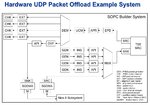beginner_EDA
Full Member level 4
Hi,
I have two components:
1. Input: 1st component with 10 bit ADC and running at 100 MHz
2. output: 2nd component with Ethernet having 32 bit Avalon sink and also running at 100 MHz.
My aim is to connect both components and achieve full load/speed by using all 32 bit width of Ethernet. But the input is not only 10 bit and also running at same speed(100 MHz).
How I can map 10 bit input -> 32 bit output and at the same time maintaining full speed of Ethernet?
Here I read there is a possibility of using FIFO with different bit width but only multiple of 2.
https://www.altera.com/literature/ug/ug_fifo.pdf
Any idea will be highly appreciated?
Regards
I have two components:
1. Input: 1st component with 10 bit ADC and running at 100 MHz
2. output: 2nd component with Ethernet having 32 bit Avalon sink and also running at 100 MHz.
My aim is to connect both components and achieve full load/speed by using all 32 bit width of Ethernet. But the input is not only 10 bit and also running at same speed(100 MHz).
How I can map 10 bit input -> 32 bit output and at the same time maintaining full speed of Ethernet?
Here I read there is a possibility of using FIFO with different bit width but only multiple of 2.
https://www.altera.com/literature/ug/ug_fifo.pdf
Any idea will be highly appreciated?
Regards
